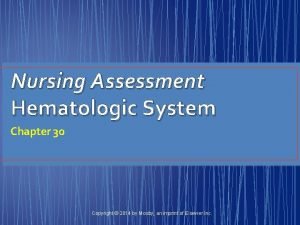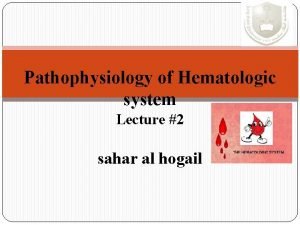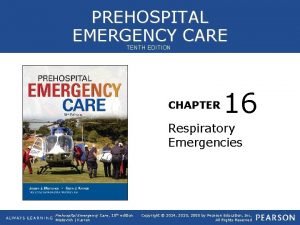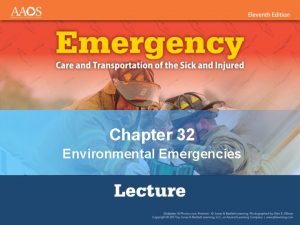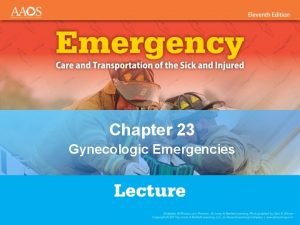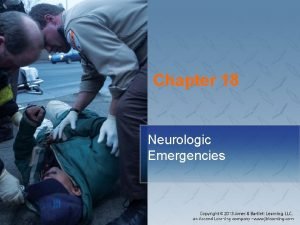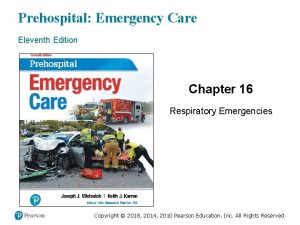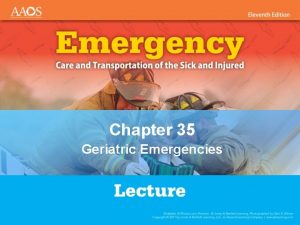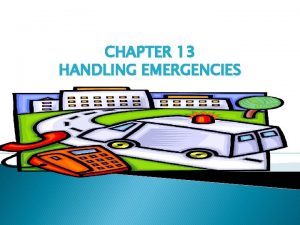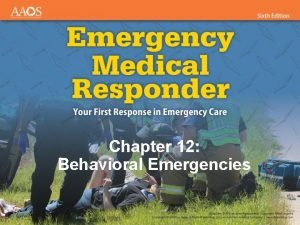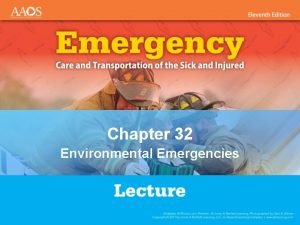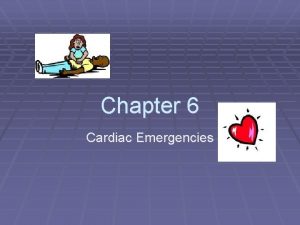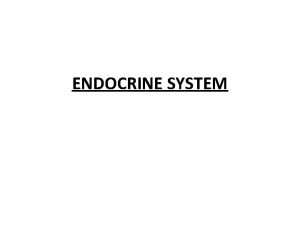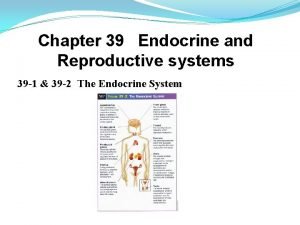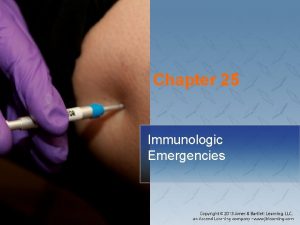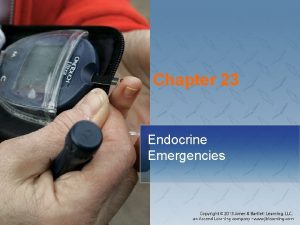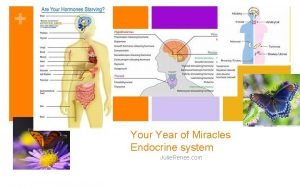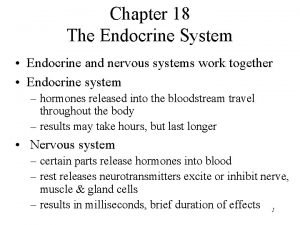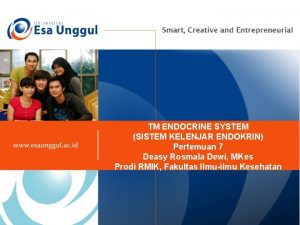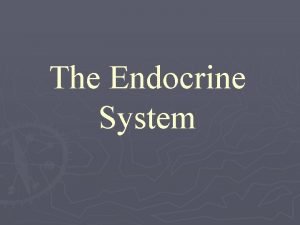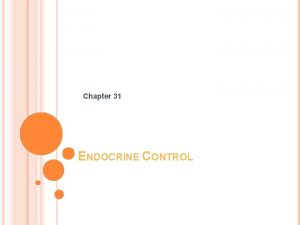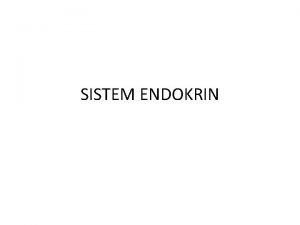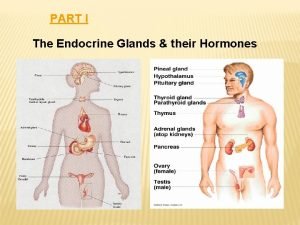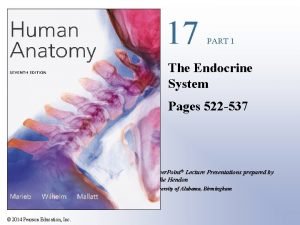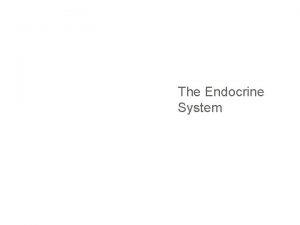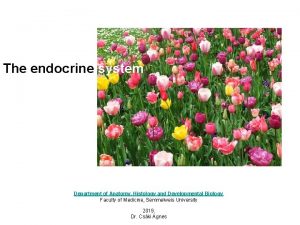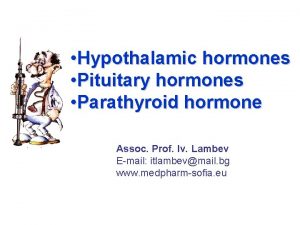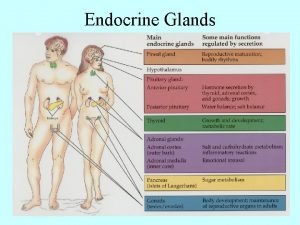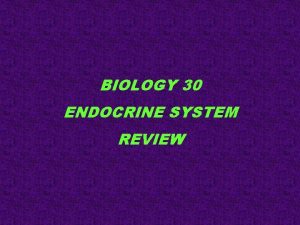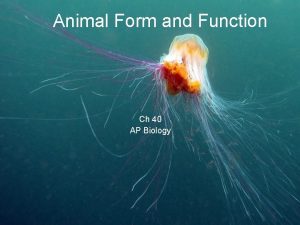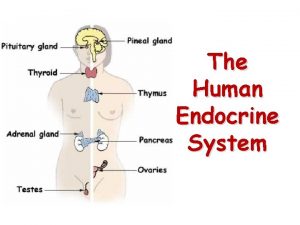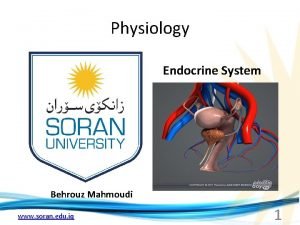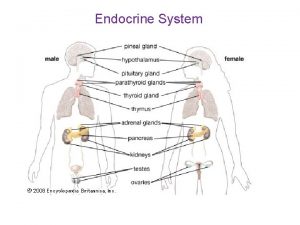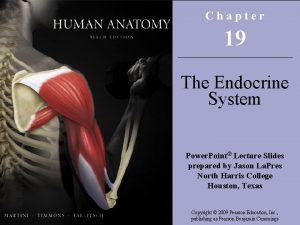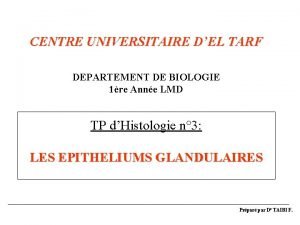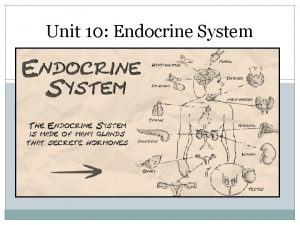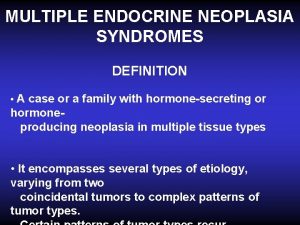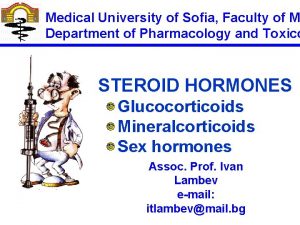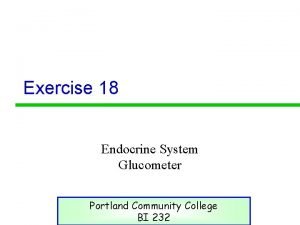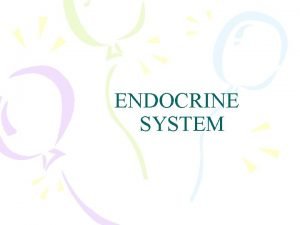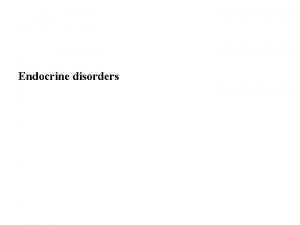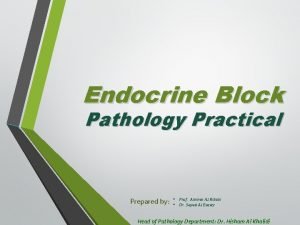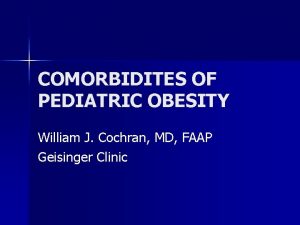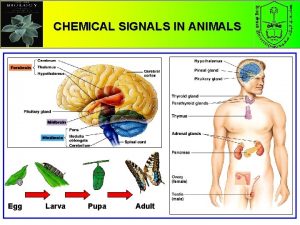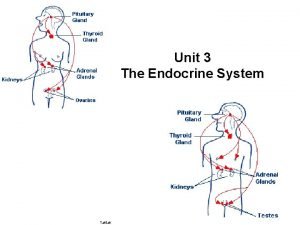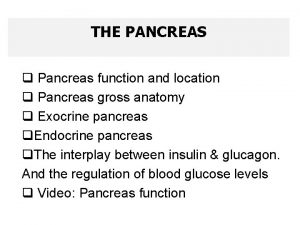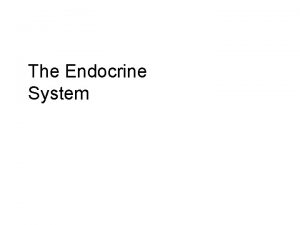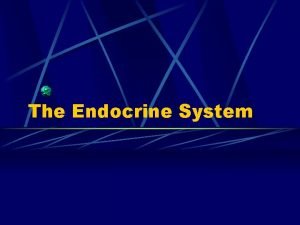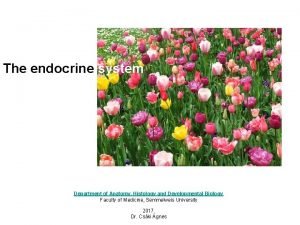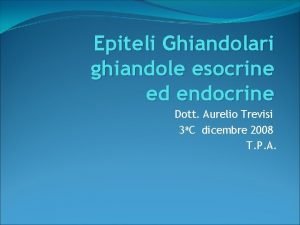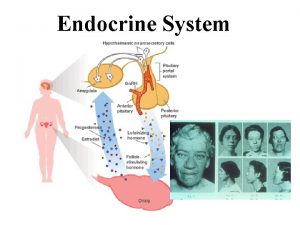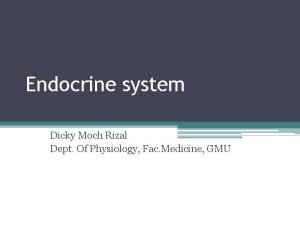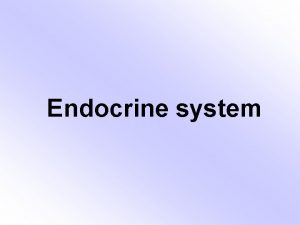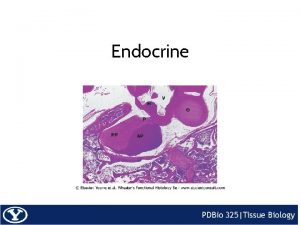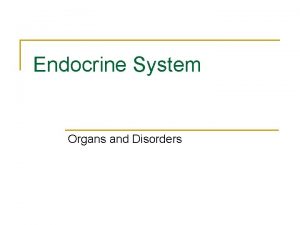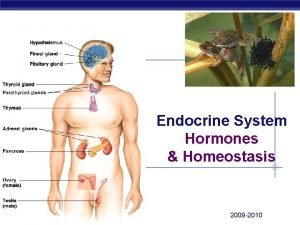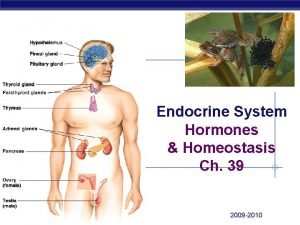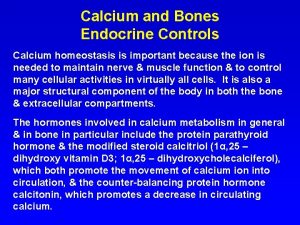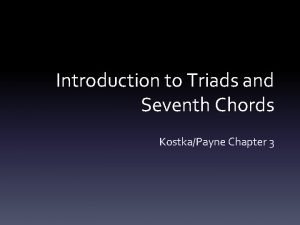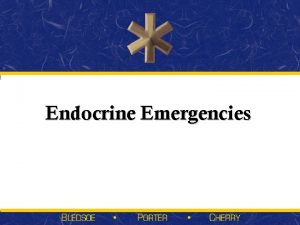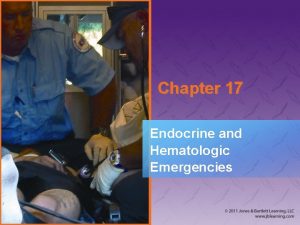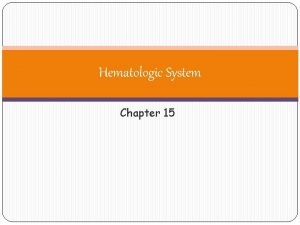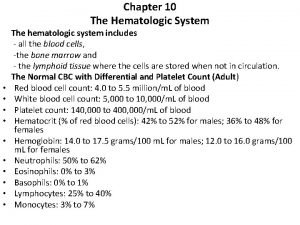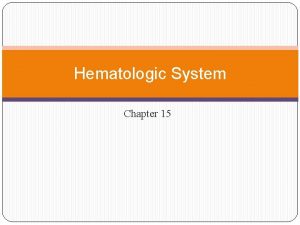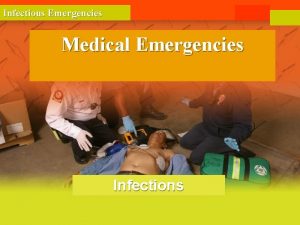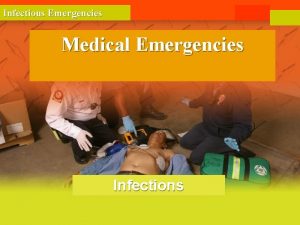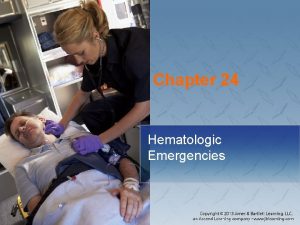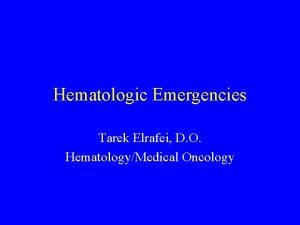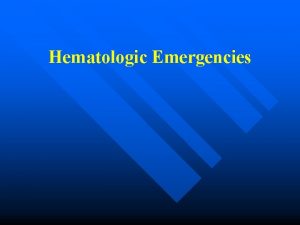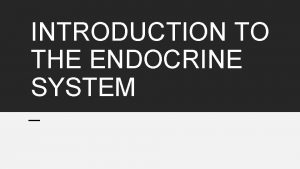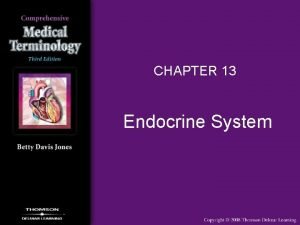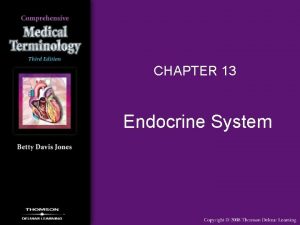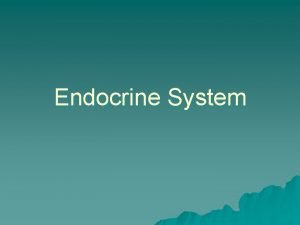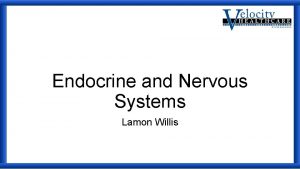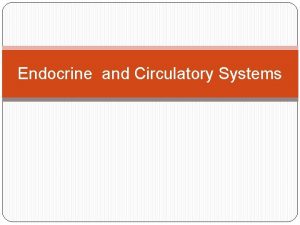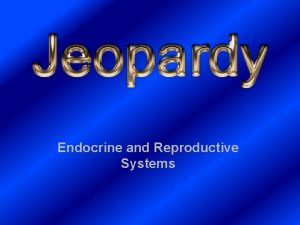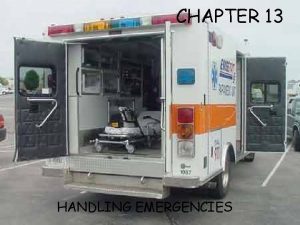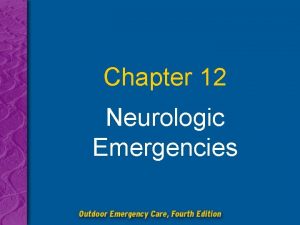Chapter 19 Endocrine and Hematologic Emergencies Introduction Endocrine


















































































































- Slides: 114

Chapter 19 Endocrine and Hematologic Emergencies

Introduction • Endocrine system influences nearly every cell, organ, and bodily function. • Endocrine disorders can have many signs and symptoms. • Hematologic emergencies – Difficult to assess and treat – Your actions may save a life.

Anatomy and Physiology (1 of 2) • Endocrine system is a communication system that controls functions inside the body. • Endocrine glands secrete messenger hormones. • Endocrine disorders are caused by an internal communication problem.

Anatomy and Physiology (2 of 2) • Glucose metabolism – The brain needs glucose and oxygen. – Insulin is necessary for glucose to enter cells. – The pancreas produces glucagon and insulin. • Stores and secretes insulin and glucagon in response the blood glucose level

Pathophysiology (1 of 2) • Diabetes mellitus impairs the body’s ability to use glucose for fuel. • Without treatment, blood glucose levels become too high. – In severe cases, may cause life-threatening illness, or coma and death • Complications include blindness, cardiovascular disease, and kidney failure.

Pathophysiology (2 of 2) • You need to know signs and symptoms of blood glucose that is: – High (hyperglycemia) – Low (hypoglycemia) • Hyperglycemia and hypoglycemia can occur with diabetes mellitus type 1 and type 2. • All hypoglycemic patients require prompt treatment.

Diabetes Mellitus Type 1 (1 of 5) • Autoimmune disorder where the immune system produces antibodies against the pancreatic beta cells – Missing the pancreatic hormone insulin • Onset usually happens from early childhood through the fourth decade of life. • Patient must obtain insulin from an external source

Diabetes Mellitus Type 1 (2 of 5) • Many people with type 1 diabetes have an implanted insulin pump. – Continuously measures glucose levels and provides an adjustable infusion of insulin – Can malfunction and diabetic emergencies can develop – Always inquire about the presence of an insulin pump.

Diabetes Mellitus Type 1 (3 of 5) • Most common metabolic disease of childhood • New-onset patient symptoms: – – – Polyuria Polydipsia Polyphagia Weight loss Fatigue

Diabetes Mellitus Type 1 (4 of 5) • Patient’s blood glucose level is above normal – Kidney’s filtration system becomes overwhelmed and glucose spills into the urine. • Glucose is unavailable to cells. – – Body turns to burning fat. Produces acid waste (ketones) Kidneys cannot maintain acid–base balance. Kussmaul respirations result

Diabetes Mellitus Type 1 (5 of 5) • If fat metabolism and ketone production continue, diabetic ketoacidosis (DKA) can develop. • May present as generalized illness • DKA can result in death. – Obtain patient’s history and presentation. – Obtain a glucose level. • Generally higher than 400 mg/d. L

Diabetes Mellitus Type 2 (1 of 3) • Caused by resistance to the effects of insulin at the cellular level – An association between obesity and increased resistance to the effects of insulin – Pancreas produces more insulin to make up for the increased levels of blood glucose and dysfunction of cellular insulin receptors. – Insulin resistance can sometimes be improved by exercise and dietary modification.

Diabetes Mellitus Type 2 (2 of 3) • Oral medications used to treat type 2 diabetes – Some increase secretion of insulin and pose a high risk of hypoglycemic reaction. – Some stimulate receptors for insulin. – Others decrease the effects of glucagon and decrease the release of glucose stored in the liver. • Injectable medications and insulin are also used for type 2 diabetes.

Diabetes Mellitus Type 2 (3 of 3) • Often diagnosed at a yearly medical examination from complaints related to high blood glucose levels, including: – Recurrent infection – Change in vision – Numbness in the feet

Symptomatic Hyperglycemia (1 of 3) • Occurs when blood glucose levels are high • Patient is in a state of altered mental status resulting from several combined problems. – In type 1 diabetes, leads to ketoacidosis with dehydration from excessive urination – In type 2 diabetes, leads to a nonketotic hyperosmolar state of dehydration

Symptomatic Hyperglycemia (2 of 3) • Hyperosmolar hyperglycemic nonketotic syndrome (HHNS) – When blood glucose levels are not controlled in diabetes mellitus type 2 – Key signs and symptoms

Symptomatic Hyperglycemia (3 of 3) • Higher glucose levels in the blood cause the excretion of glucose in the urine. – Patient increases fluid intake. – Patient cannot drink enough fluid to keep up with the exceedingly high glucose levels in the blood. – Urine becomes dark and concentrated. – Patient may become unconscious or have seizure activity due to severe dehydration.

Symptomatic Hypoglycemia (1 of 3) • Acute emergency where a patient’s blood glucose level drops and must be corrected swiftly – Can occur in patients who inject insulin or use oral medications – When insulin levels remain high, glucose is rapidly taken out of the blood. – If glucose levels fall, there may be an insufficient amount to supply the brain.

Symptomatic Hypoglycemia (2 of 3) • Mental status declines. – Patient may become aggressive or display unusual behavior. – Unconsciousness or permanent brain damage can quickly follow. • Hypoglycemia develops much more quickly than hyperglycemia. • Signs and symptoms of hypoglycemia

Symptomatic Hypoglycemia (3 of 3) • Hypoglycemia is quickly reversed by giving the patient glucose. © Jones and Bartlett Learning.

Scene Size-up • Scene safety – Patients with diabetes may use syringes. – Be alert for clues. – Use standard precautions. – Question bystanders on events leading to your arrival. – Keep open the possibility that trauma may have occurred. • Determine MOI/NOI.

Primary Assessment (1 of 3) • Form a general impression. • Airway and breathing – Patients showing signs of inadequate breathing, a pulse oximetry level less than or equal to 94%, or altered mental status should receive high-flow oxygen (12 to 15 L/min via nonrebreathing mask).

Primary Assessment (2 of 3) • Airway and breathing (cont’d) – Hyperglycemic patients may have Kussmaul respirations and sweet, fruity breath. – Hypoglycemic patients will have normal or shallow to rapid respirations. – Manage respiratory distress.

Primary Assessment (3 of 3) • Circulatory status – Dry, warm skin: hyperglycemia – Moist, pale skin: hypoglycemia – Rapid, weak pulse: symptomatic hypoglycemia • Transport decision – Transport promptly patients with altered mental status and impaired ability to swallow.

History Taking (1 of 2) • Investigate chief complaint. – Obtain history of present illness from responsive patient, family, or bystanders. – If patient has eaten but not taken insulin, hyperglycemia is more likely. – If patient has taken insulin but not eaten, hypoglycemia is more likely. – Carefully observe signs and symptoms; determine whether hypo- or hyperglycemic.

History Taking (2 of 2) • SAMPLE history—ask the patient: – Do you take insulin or pills to lower blood sugar? – Do you wear an insulin pump? – Have you taken your usual insulin dose (or pills) today? – Have you eaten normally today? – Have you had any illness, unusual amount of activity, or stress?

Secondary Assessment (1 of 3) • Physical examination – Assess unresponsive patients from head to toe. – When you suspect a diabetes-related problem, focus on mental status, ability to swallow, and ability to protect airway. • Obtain a Glasgow Coma Scale score.

Secondary Assessment (2 of 3) • Vital signs – Use a glucometer, if available and protocols allow. – Hypoglycemia: Respirations are normal to rapid, pulse is weak and rapid, and skin is typically pale and clammy with a low blood pressure – Hyperglycemia: Respirations may be deep and rapid; pulse may be rapid, weak, and thready; and skin may be warm and dry with a normal blood pressure

Secondary Assessment (3 of 3) • Portable glucometer – Study the operator’s manual for proper use in the field. – Know the upper and lower ranges at which your glucometer functions. – Normal nonfasting adult and child blood glucose level range: 80 to 120 mg/d. L; neonates should be above 70 mg/d. L

Reassessment (1 of 3) • Interventions – Reassess patient with diabetes frequently. – For hypoglycemic, conscious patients who can swallow: • Encourage patient to take glucose tablets or drink juice containing sugar. • Administer gel preparation or sugar drink (if protocols allow). • Provide rapid transport.

Reassessment (2 of 3) • Interventions (cont’d) – Hypoglycemic, unconscious patient at risk of aspiration: • Patient needs intravenous (IV) glucose or intramuscular (IM) or intranasal (IN) glucagon (beyond EMT competencies). – When in doubt, consult medical control.

Reassessment (3 of 3) • If unable to test for a blood glucose value: – Perform a thorough assessment. – Contact the hospital to help sort out the signs and symptoms. • Coordinate communication and documentation. – Patients who refuse transport after oral glucose may require more thorough documentation.

Emergency Medical Care for Diabetic Emergencies (1 of 2) • Giving oral glucose • Three types of oral glucose: Accu-Chek® Aviva used with permission of Roche Diagnostics. – Rapidly dissolving gel – Large chewable tablets – Liquid formulation

Emergency Medical Care for Diabetic Emergencies (2 of 2) • Oral glucose (cont’d) – Contraindications: inability to swallow and unconsciousness – Wear gloves before putting anything in patient’s mouth. – Follow local protocols for glucose administration. • Reassess frequently. • Provide transport.

The Presentation of Hypoglycemia (1 of 4) • Seizures should be considered very serious. – Hypoglycemia is a possible cause of seizures. – May indicate a potentially life-threatening underlying condition – Management

The Presentation of Hypoglycemia (2 of 4) • Altered mental status – May be caused by other conditions – May be caused by diabetes complications – Use the mnemonic AEIOU-TIPS. – Management

The Presentation of Hypoglycemia (3 of 4) • Misdiagnosis of neurologic dysfunction – Symptoms mistaken for intoxication – A patient with diabetes confined by police is at risk. – Look for emergency medical identification. – Perform blood glucose test at scene (if protocols allow). – Diabetes and alcoholism can coexist in a patient.

The Presentation of Hypoglycemia (4 of 4) • Relationship to airway management – May not have a gag reflex – Vomit or tongue may obstruct airway. – Carefully monitor airway. – Place patient in lateral recumbent position. – Make sure suction is available.

Hematologic Emergencies • Hematology is the study of blood-related diseases. • Three disorders that can create a prehospital emergency: – Sickle cell disease – Hemophilia A – Thrombophilia

Anatomy and Physiology • Blood is made up of four components. – Red blood cells contain hemoglobin, which carries oxygen to the tissues. – White blood cells respond to infection and collect dead cells for their correct disposal. – Platelets assist in clot formation. – Plasma serves as the transportation medium.

Pathophysiology (1 of 7) • Sickle cell disease – Inherited disorder, affects red blood cells – Predominantly in people of African, Caribbean, and South American ancestry – People with sickle cell disease have misshapen RBCs that lead to dysfunction in oxygen binding and unintentional clot formation. • Clots may result in a blockage known as vasoocclusive crisis. • Can result in hypoxia, pain, and organ damage

Pathophysiology (2 of 7) • Sickle cell disease (cont’d) – Sickled cells have a short life span – Results in more cellular waste products and contributing to sludging of the blood • Complications include: – – – Anemia Gallstones Jaundice Splenic dysfunction Vascular occlusion with ischemia

Pathophysiology (3 of 7) • Sickle cell disease (cont’d) – Many of these complications are very painful and potentially life threatening. © Science Picture Co/Science Source.

Pathophysiology (4 of 7) • Clotting disorders—hemophilia – Rare: Only about 20, 000 Americans have the disorder. – Hemophilia A affects mostly males. – Decreased ability to create a clot after an injury, which can be life threatening – Patients typically have intravenous factor VIII replacement infusions (which help the blood clot) close at hand.

Pathophysiology (5 of 7) • Clotting disorders—thrombophilia – Disorder in the body’s ability to maintain the smooth flow of blood through the venous and arterial systems – Concentration of particular elements in the blood creates clogging or blockage issues – General term for many conditions that result in blood clotting more easily than normal – Clots can spontaneously develop in the blood of the patient.

Pathophysiology (6 of 7) • Clotting disorders—deep vein thrombosis (DVT) – Common medical problem in sedentary patients and in patients who have had recent injury or surgery – Methods designed to prevent blood clot formation, include: • Blood-thinning medications • Compression stockings • Mechanical devices

Pathophysiology (7 of 7) • Clotting disorders—DVT (cont’d) – Risk factors – Treatment • Anticoagulation therapy • Oral medications typically administered for at least 3 months after diagnosis of a DVT – A clot from the DVT can travel from the patient’s lower extremity to the lung, causing a pulmonary embolus.

Scene Size-up • Scene safety – Most sickle cell patients will have had a crisis before. – Wear gloves and eye protection at a minimum. – Consider ALS support. • MOI/NOI – Remember, trauma may also have occurred.

Primary Assessment (1 of 2) • Perform cervical spine immobilization, if necessary. • Form a general impression. • Airway and breathing – Inadequate breathing or altered mental status: • High-flow oxygen at 12 to 15 L/min via nonrebreathing mask • Sickle cell crisis patients may have increased respirations or signs of pneumonia.

Primary Assessment (2 of 2) • Circulation – Sickle cell patients: increased heart rate – Hemophilia: • Be alert for signs of acute blood loss. • Note bleeding of unknown origin. • Be alert for signs of hypoxia. • Make a transport decision. – Transport to an ED is recommended for any patient with sickle cell crisis or hemophilia.

History Taking (1 of 3) • Investigate chief complaint. – Obtain history of present illness from responsive patients, family, or bystanders. – Be alert for physical signs indicating sickle cell crisis.

History Taking (2 of 3) • Ask about: – Is pain isolated in single location or felt throughout body? – Visual disturbances? – Nausea, vomiting, or abdominal cramping? – Chest pain or shortness of breath?

History Taking (3 of 3) • Obtain SAMPLE history from responsive patient or family member. – Have you had a crisis before? – When was the last time you had a crisis? – How did your last crisis resolve? – Recent illness, unusual amount of activity, or stress?

Secondary Assessment • Physical examination – Focus on major joints. – Evaluate and documental status using AVPU. • Vital signs – Obtain complete set of vital signs. • Look for signs of sickle cell crisis. • Use pulse oximeter, if available.

Reassessment • Reassess vital signs frequently. • Evaluate interventions and adjust or change as necessary. • Administer supplemental oxygen via nonrebreathing mask at 12 to 15 L/min. • Communicate with hospital staff for continuity of care and document clearly.

Emergency Medical Care for Hematologic Disorders • Mainly supportive and symptomatic • Patients with inadequate breathing or altered mental status: – Administer high-flow oxygen at 12 to 15 L/min via nonrebreathing mask. – Place in a position of comfort. – Transport rapidly to hospital.

Review 1. Type 1 diabetes is a condition in which: A. too much insulin is produced. B. glucose utilization is impaired. C. too much glucose enters the cell. D. the body does not produce glucose.

Review Answer: B Rationale: Type 1 diabetes is a disease in which the pancreas fails to produce enough insulin (or produces none at all). Insulin is a hormone that promotes the uptake of sugar from the bloodstream and into the cells. Without insulin, glucose utilization is impaired because it cannot enter the cell.

Review (1 of 2) 1. Type 1 diabetes is a condition in which: A. too much insulin is produced. Rationale: The body only produces the amount of insulin that is needed to enable glucose to enter cells. B. glucose utilization is impaired. Rationale: Correct answer

Review (2 of 2) 1. Type 1 diabetes is a condition in which: C. too much glucose enters the cell. Rationale: An abnormally high blood glucose level is known as hyperglycemia. D. the body does not produce glucose. Rationale: Glucose is derived from the oral intake of carbohydrates. It is stored in different body structures and then metabolized by cells.

Review 2. A 45 -year-old man with type 1 diabetes is found unresponsive. Which of the following questions is MOST important to ask his wife? A. “Did he take his insulin today? ” B. “How long has he been a diabetic? ” C. “Has he seen his physician recently? ” D. “What kind of insulin does he take? ”

Review Answer: A Rationale: All of these questions are important to ask the spouse of an unconscious diabetic. However, it is critical to ask if the patient took his insulin. This will help you differentiate hypoglycemic crisis from hyperglycemic crisis. For example, if the patient took his insulin and did not eat, or accidentally took too much insulin, you should suspect hypoglycemic crisis. If the patient did not take his insulin, you should suspect hyperglycemic crisis.

Review (1 of 2) 2. A 45 -year-old man with type 1 diabetes is found unresponsive. Which of the following questions is MOST important to ask his wife? A. “Did he take his insulin today? ” Rationale: Correct answer B. “How long has he been a diabetic? ” Rationale: This is useful SAMPLE history information.

Review (2 of 2) 2. A 45 -year-old man with type 1 diabetes is found unresponsive. Which of the following questions is MOST important to ask his wife? C. “Has he seen his physician recently? ” Rationale: This is also important SAMPLE history information. D. “What kind of insulin does he take? ” Rationale: This provides important information about a patient’s medications.

Review 3. A diabetic patient presents with a blood glucose level of 310 mg/d. L and severe dehydration. The patient’s dehydration is the result of: A. excretion of glucose and water from the kidneys. B. a deficiency of insulin that causes internal fluid loss. C. an infection that often accompanies hyperglycemia. D. an inability to produce energy because of insulin depletion.

Review Answer: A Rationale: In severe hyperglycemia, the kidneys excrete excess glucose from the body. This process requires a large amount of water to accomplish; therefore, water is excreted with the glucose, resulting in dehydration.

Review (1 of 4) 3. A diabetic patient presents with a blood glucose level of 310 mg/d. L and severe dehydration. The patient’s dehydration is the result of: A. excretion of glucose and water from the kidneys. Rationale: Correct answer

Review (2 of 4) 3. A diabetic patient presents with a blood glucose level of 310 mg/d. L and severe dehydration. The patient’s dehydration is the result of: B. a deficiency of insulin that causes internal fluid loss. Rationale: A lack of insulin will cause the glucose level to rise, and it is the glucose that causes the fluid loss.

Review (3 of 4) 3. A diabetic patient presents with a blood glucose level of 310 mg/d. L and severe dehydration. The patient’s dehydration is the result of: C. an infection that often accompanies hyperglycemia. Rationale: An infection is an invasion of the body by an organism—glucose is not a foreign element.

Review (4 of 4) 3. A diabetic patient presents with a blood glucose level of 310 mg/d. L and severe dehydration. The patient’s dehydration is the result of: D. an inability to produce energy because of insulin depletion. Rationale: A body’s inability to metabolize glucose does not cause a fever.

Review 4. Which combination of factors would MOST likely cause a hypoglycemic crisis in a diabetic patient? A. Eating a meal and taking insulin B. Skipping a meal and taking insulin C. Eating a meal and not taking insulin D. Skipping a meal and not taking insulin

Review Answer: B Rationale: The combination that would most likely cause a hypoglycemic crisis is skipping a meal and taking insulin. The patient will use up all available glucose in the bloodstream and become hypoglycemic. Left untreated, hypoglycemic crisis may cause permanent brain damage or even death.

Review (1 of 2) 4. Which combination of factors would MOST likely cause a hypoglycemic crisis in a diabetic patient? A. Eating a meal and taking insulin Rationale: This process will maintain the body’s glucose level. B. Skipping a meal and taking insulin Rationale: Correct answer

Review (2 of 2) 4. Which combination of factors would MOST likely cause a hypoglycemic crisis in a diabetic patient? C. Eating a meal and not taking insulin Rationale: Eating will cause the glucose levels to rise. D. Skipping a meal and not taking insulin Rationale: Glucose levels should remain the same but may be influenced by the patient’s metabolic rate or physical activities. This does not cause a hypoglycemic crisis.

Review 5. A 19 -year-old diabetic male was found unresponsive on the couch by his roommate. After confirming that the patient is unresponsive, you should: A. suction his oropharynx. B. manually open his airway. C. administer high-flow oxygen. D. begin assisting his ventilations.

Review Answer: B Rationale: Immediately after determining that a patient is unresponsive, your first action should be to manually open his or her airway (eg, head tilt–chin lift, jaw-thrust). Use suction as needed to clear secretions from the patient’s mouth. After manually opening the airway and ensuring it is clear of obstructions, insert an nasal airway adjunct and then assess the patient’s breathing.

Review (1 of 2) 5. A 19 -year-old diabetic male was found unresponsive on the couch by his roommate. After confirming that the patient is unresponsive, you should: A. suction his oropharynx. Rationale: After opening the airway, suction as needed to remove any secretions. B. manually open his airway. Rationale: Correct answer

Review (2 of 2) 5. A 19 -year-old diabetic male was found unresponsive on the couch by his roommate. After confirming that the patient is unresponsive, you should: C. administer high-flow oxygen. Rationale: After opening the airway, provide oxygen only as clinically indicated. D. begin assisting his ventilations. Rationale: After opening the airway, assist with ventilations if the patient’s breathing is inadequate.

Review 6. What breathing pattern would you MOST likely encounter in a patient with diabetic ketoacidosis (DKA)? A. Slow and shallow B. Shallow and irregular C. Rapid and deep D. Slow and irregular

Review Answer: C Rationale: Kussmaul respirations—a rapid and deep breathing pattern seen in patients with DKA—indicates that the body is attempting to eliminate ketones via the respiratory system. A fruity or acetone breath odor is usually present in patients with Kussmaul respirations.

Review (1 of 2) 6. What breathing pattern would you MOST likely encounter in a patient with diabetic ketoacidosis (DKA)? A. Slow and shallow Rationale: Agonal respirations are seen with cerebral anoxia and may have an occasional gasp. B. Shallow and irregular Rationale: Agonal respirations are seen with cerebral anoxia and may have an occasional gasp.

Review (2 of 2) 6. What breathing pattern would you MOST likely encounter in a patient with diabetic ketoacidosis (DKA)? C. Rapid and deep Rationale: Correct answer D. Slow and irregular Rationale: Slow and irregular respiration results from increased intracranial pressure and can also have periods of apnea.

Review 7. A woman called EMS because her 12 -yearold son, who had been experiencing excessive urination, thirst, and hunger for the past 36 hours, has an altered mental status and is breathing fast. You should be MOST suspicious for: A. B. C. D. low blood sugar. hypoglycemia. hypoglycemic crisis. hyperglycemic crisis.

Review Answer: D Rationale: The child is experiencing a hyperglycemic crisis secondary to severe hyperglycemia. Hyperglycemic crisis is characterized by a slow onset and excessive urination (polyuria), thirst (polydipsia), and hunger (polyphagia). Other signs include rapid, deep breathing with a fruity or acetone breath odor (Kussmaul respirations); a rapid, thready pulse; and an altered mental status.

Review (1 of 2) 7. A woman called EMS because her 12 -year-old son, who had been experiencing excessive urination, thirst, and hunger for the past 36 hours, has an altered mental status and is breathing fast. You should be MOST suspicious for: A. low blood sugar. Rationale: Low blood sugar does not cause frequent urination. B. hypoglycemia. Rationale: Hypoglycemia is low blood sugar.

Review (2 of 2) 7. A woman called EMS because her 12 -year-old son, who had been experiencing excessive urination, thirst, and hunger for the past 36 hours, has an altered mental status and is breathing fast. You should be MOST suspicious for: C. hypoglycemic crisis. Rationale: Hypoglycemic crisis does not produce any of these symptoms. D. hyperglycemic crisis. Rationale: Correct answer

Review 8. If the cells do not receive glucose, they will begin to metabolize: A. fat. B. acid. C. sugar. D. ketones.

Review Answer: A Rationale: If the body’s cells do not receive glucose, they will begin to metabolize the next most readily available substance—fat. Fat metabolism results in the production of ketoacids, which are released into the bloodstream (hence the term “ketoacidosis”).

Review (1 of 2) 8. If the cells do not receive glucose, they will begin to metabolize: A. fat. Rationale: Correct answer B. acid. Rationale: Fatty acids are a by-product (waste product) of the metabolism of fat.

Review (2 of 2) 8. If the cells do not receive glucose, they will begin to metabolize: C. sugar. Rationale: Sugar is glucose. D. ketones. Rationale: Ketones are a by-product (waste product) of the metabolism of fat.

Review 9. In contrast to a hyperglycemic crisis, a hypoglycemic crisis: A. rarely presents with seizures. B. presents over a period of hours to days. C. should not routinely be treated with glucose. D. usually responds immediately after treatment.

Review Answer: D Rationale: Hypoglycemic crisis usually responds immediately following treatment with glucose. Patients with hyperglycemic crisis generally respond to treatment gradually, within 6– 12 hours following the appropriate treatment. Seizures can occur with both hyperglycemic crisis and hypoglycemic crisis, but are more common in patients with hypoglycemic crisis.

Review (1 of 2) 9. In contrast to a hyperglycemic crisis, a hypoglycemic crisis: A. rarely presents with seizures. Rationale: Hypoglycemic crisis can produce seizures. B. presents over a period of hours to days. Rationale: Hypoglycemic crisis has a rapid onset of symptoms (possible minutes).

Review (2 of 2) 9. In contrast to a hyperglycemic crisis, a hypoglycemic crisis: C. should not routinely be treated with glucose. Rationale: Hypoglycemic crisis is always treated with glucose. D. usually responds immediately after treatment. Rationale: Correct answer

Review 10. Patients with diabetic ketoacidosis experience polydipsia because: A. they are dehydrated secondary to excessive urination. B. the cells of the body are starved due to a lack of glucose. C. fatty acids are being metabolized at the cellular level. D. hyperglycemia usually causes severe internal water loss.

Review Answer: A Rationale: Severe hyperglycemia—which leads to diabetic ketoacidosis—causes the body to excrete large amounts of glucose and water. As a result, the patient becomes severely dehydrated, which leads to excessive thirst (polydipsia).

Review (1 of 2) 10. Patients with diabetic ketoacidosis experience polydipsia because: A. they are dehydrated secondary to excessive urination. Rationale: Correct answer B. the cells of the body are starved due to a lack of glucose. Rationale: True, but the lack of glucose does not cause thirst.

Review (2 of 2) 10. Patients with diabetic ketoacidosis experience polydipsia because: C. fatty acids are being metabolized at the cellular level. Rationale: Fats are metabolized by the cells instead of glucose, which produces acids and ketones—thus the term ketoacidosis. D. hyperglycemia usually causes severe internal water loss. Rationale: This is false. It causes water loss due to glucose being excreted (externally) in the urine solution.

Review 11. When dealing with hematologic disorders, the EMT must be familiar with the composition of blood. Which of the following is considered a hematologic disease? A. Sickle cell disease B. Hemophilia C. Lou Gehrig’s disease D. Both A and B

Review Answer: D Rationale: Hematology is the study and prevention of blood-related diseases, such as sickle cell disease and hemophilia.

Review (1 of 2) 11. When dealing with hematologic disorders, the EMT must be familiar with the composition of blood. Which of the following is considered a hematologic disease? A. Sickle cell disease Rationale: Sickle cell disease is a hematologic disorder affecting the red blood cells. B. Hemophilia Rationale: Hemophilia is a hematologic disorder affecting the blood’s ability to clot.

Review (2 of 2) 11. When dealing with hematologic disorders, the EMT must be familiar with the composition of blood. Which of the following is considered a hematologic disease? C. Lou Gehrig’s disease Rationale: Lou Gehrig’s disease affects the nerve cells in the brain and spinal cord. D. Both A and B Rationale: Correct answer

Review 12. What are the two main components of blood? A. Erythrocytes and hemoglobin B. Cells and plasma C. Leukocytes and white blood cells D. Platelets and neutrophils

Review Answer: B Rationale: The blood is made up of two main components: cells and plasma. The cells in the blood include red blood cells (erythrocytes), white blood cells (leukocytes), and platelets. These cells are suspended in a straw-colored fluid called plasma.

Review (1 of 2) 12. What are the two main components of blood? A. Erythrocytes and hemoglobin Rationale: Erythrocytes are a type of blood cell, and hemoglobin is a chemical that is contained within blood cells. B. Cells and plasma Rationale: Correct answer

Review (2 of 2) 12. What are the two main components of blood? C. Leukocytes and white blood cells Rationale: Leukocytes are white blood cells, which are a type of blood cell. D. Platelets and neutrophils Rationale: Platelets are a type of blood cell, and neutrophils are a type of white blood cell.

Review 13. The assessment of a patient with a hematologic disorder is the same as it is with all other patients an EMT will encounter. In addition to obtaining a SAMPLE history, EMTs should ask which of the following questions? A. B. C. D. Have you had a crisis before? When was the last time you had a crisis? How did your crisis resolve? All of the above.

Review Answer: D Rationale: SAMPLE is the mnemonic used in taking the history of all patients. In addition to asking the SAMPLE, EMTs should also ask about past crises.

Review (1 of 2) 13. The assessment of a patient with a hematologic disorder is the same as it is with all other patients an EMT will encounter. In addition to obtaining a SAMPLE history, EMTs should ask which of the following questions? A. Have you had a crisis before? Rationale: You should ask the patient this question. B. When was the last time you had a crisis? Rationale: You should ask the patient this question.

Review (2 of 2) 13. The assessment of a patient with a hematologic disorder is the same as it is with all other patients an EMT will encounter. In addition to obtaining a SAMPLE history, EMTs should ask which of the following questions? C. How did your crisis resolve? Rationale: You should ask the patient this question. D. All of the above. Rationale: Correct answer

Review 14. Which one of the following is NOT an appropriate treatment for EMTs to provide to a patient who has a hematologic disorder? A. B. C. D. Analgesics for pain Support of symptoms High-flow oxygen therapy at 12 to 15 L/min Rapid transport

Review Answer: A Rationale: Although analgesics would benefit a patient suffering from a hematologic disorder, the administration of such medications is not in the scope of practice for the EMT. ALS providers would have to be present to provide this emergency care.

Review (1 of 2) 14. Which one of the following is NOT an appropriate treatment for EMTs to provide to a patient who has a hematologic disorder? A. Analgesics for pain Rationale: Correct answer B. Support of symptoms Rationale: This is an appropriate treatment.

Review (2 of 2) 14. Which one of the following is NOT an appropriate treatment for EMTs to provide to a patient who has a hematologic disorder? C. High-flow oxygen therapy at 12 to 15 L/min Rationale: This is an appropriate treatment. D. Rapid transport Rationale: This is an appropriate treatment.
 Chapter 19 endocrine and hematologic emergencies
Chapter 19 endocrine and hematologic emergencies Assessment of hematologic system
Assessment of hematologic system Hypochromic red cells
Hypochromic red cells Hematologic system assessment
Hematologic system assessment Emt chapter 18 gastrointestinal and urologic emergencies
Emt chapter 18 gastrointestinal and urologic emergencies Chapter 28 lesson 1
Chapter 28 lesson 1 Chapter 16 respiratory emergencies
Chapter 16 respiratory emergencies Chapter 32 environmental emergencies
Chapter 32 environmental emergencies Chapter 23 gynecologic emergencies
Chapter 23 gynecologic emergencies Chapter 22 psychiatric emergencies
Chapter 22 psychiatric emergencies Chapter 18 neurologic emergencies
Chapter 18 neurologic emergencies Chapter 16 respiratory emergencies
Chapter 16 respiratory emergencies Gems diamond geriatric assessment
Gems diamond geriatric assessment Chapter 13 handling emergencies
Chapter 13 handling emergencies Chapter 12 behavioral emergencies
Chapter 12 behavioral emergencies Chapter 32 environmental emergencies
Chapter 32 environmental emergencies Chapter 17 cardiovascular emergencies
Chapter 17 cardiovascular emergencies Chapter 17 neurologic emergencies
Chapter 17 neurologic emergencies Lesson 6: cardiac emergencies and using an aed
Lesson 6: cardiac emergencies and using an aed Introduction of endocrine system
Introduction of endocrine system Chapter 46 digestive and endocrine disorders
Chapter 46 digestive and endocrine disorders A hormone
A hormone Chapter 39 endocrine and reproductive systems
Chapter 39 endocrine and reproductive systems Chapter 29 endocrine and metabolic disorders
Chapter 29 endocrine and metabolic disorders Chapter 45 hormones and the endocrine system
Chapter 45 hormones and the endocrine system A diver is 30 metres/99 feet underwater
A diver is 30 metres/99 feet underwater Major nutritional deficiency diseases in emergencies
Major nutritional deficiency diseases in emergencies Lsu hematology oncology
Lsu hematology oncology Psychiatric emergency
Psychiatric emergency Qut security contact number for emergencies
Qut security contact number for emergencies Immunologic emergencies
Immunologic emergencies Chapter 16
Chapter 16 Chapter 7:13 endocrine system
Chapter 7:13 endocrine system Endocrine glands
Endocrine glands Pituitary
Pituitary Your year of miracles
Your year of miracles Chapter 16 lesson 1 the endocrine system
Chapter 16 lesson 1 the endocrine system Lipid soluble hormones examples
Lipid soluble hormones examples Disease artinya
Disease artinya Major endocrine glands male and female
Major endocrine glands male and female Endocrine system and reproductive system
Endocrine system and reproductive system Differences between nervous system and endocrine
Differences between nervous system and endocrine Comparison of endocrine and nervous system
Comparison of endocrine and nervous system Difference between endocrine and exocrine glands
Difference between endocrine and exocrine glands Are endocrine glands ductless
Are endocrine glands ductless Whats the difference between endocrine and exocrine glands
Whats the difference between endocrine and exocrine glands Endocrine system
Endocrine system Endocrine system and nervous system
Endocrine system and nervous system Kelenjar endokrin
Kelenjar endokrin Adenohypophysis
Adenohypophysis Neuroendocrine reflex
Neuroendocrine reflex Endocrine anatomy
Endocrine anatomy Steroids endocrine system
Steroids endocrine system Facts about the endocrine system
Facts about the endocrine system Lympathic
Lympathic Rat internal organs
Rat internal organs Humoral neural and hormonal stimuli
Humoral neural and hormonal stimuli Mammillary body
Mammillary body Lamina propria of tongue
Lamina propria of tongue Humoral stimulus
Humoral stimulus Endocrine histology
Endocrine histology Endocrine axis
Endocrine axis Hypothalamus
Hypothalamus Nervous system vs endocrine system venn diagram
Nervous system vs endocrine system venn diagram Endocrine exocrine
Endocrine exocrine Thyroid gland cells
Thyroid gland cells Biology 30 endocrine system
Biology 30 endocrine system Ap biology chapter 40
Ap biology chapter 40 Estrogen effect
Estrogen effect Endocrine
Endocrine Thymus gland
Thymus gland Endocrine glands
Endocrine glands Sella turcica
Sella turcica Pearson endocrine system
Pearson endocrine system Glande endocrine exocrine
Glande endocrine exocrine Endocrine system analogy
Endocrine system analogy Multiple endocrine neoplasia type 2
Multiple endocrine neoplasia type 2 Endocrine axes
Endocrine axes Endocrine organs
Endocrine organs Classification of hormones
Classification of hormones Exocrine glands function
Exocrine glands function Endocrine disorder
Endocrine disorder Papillary thyroid carcinoma gross
Papillary thyroid carcinoma gross Endocrine weight loss
Endocrine weight loss Endocrine glands secrete
Endocrine glands secrete T4.taktak
T4.taktak Endocrine pancreas
Endocrine pancreas Endocrine glands
Endocrine glands Hyophysis
Hyophysis Endocrine vs exocrine
Endocrine vs exocrine Endocrine organ histology
Endocrine organ histology Endocrine system
Endocrine system Baylor
Baylor Glands of the endocrine system
Glands of the endocrine system Adenomero
Adenomero Endocrine parts
Endocrine parts Endocrine system
Endocrine system Endocrine sistem
Endocrine sistem Acidophils
Acidophils Structure of hypothalamus and pituitary gland
Structure of hypothalamus and pituitary gland Endocrine
Endocrine Hyophysis
Hyophysis Kliere
Kliere Endocrine system regents questions
Endocrine system regents questions Endocrine system regents questions
Endocrine system regents questions Dr friedman cushing's
Dr friedman cushing's Endocrine
Endocrine Intro paragraph outline
Intro paragraph outline Marine ecology
Marine ecology Chapter 52 an introduction to ecology and the biosphere
Chapter 52 an introduction to ecology and the biosphere Introduction to management chapter 1
Introduction to management chapter 1 Waistline
Waistline Chapter 1 introduction to accounting and business
Chapter 1 introduction to accounting and business Chapter 3 introduction to triads and seventh chords
Chapter 3 introduction to triads and seventh chords Accounting in business chapter 1
Accounting in business chapter 1

